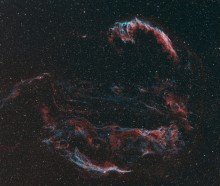Well, here we are again: June is upon us, it doesn’t get dark till nearly midnight, it’s bright again by half 4, and many stargazers will be thinking about putting away their scopes till autumn. I think I mentioned in a previous piece, though, how much I enjoy summer observing, and had a brilliant session on Friday last.
Although it was still very light at 11, and very hazy and humid, Mars, Jupiter and Saturn were high and bright enough to be well worth having a look at. Mars, usually a tricky planet to observe was big (because it’s at opposition), high enough to be less shimmery than usual, and, although still very bright, gave up some detail: dark patches on the surface; a bright patch at the top (the planet’s polar ice cap) … I know it may not sound very exciting, but trust me, it was very special.
As good as Mars was, I was blown away by Saturn. Big and bright, with very clear and crisp rings and Cassini division, and even cloud bands on the planet’s surface … amazing! I also had a good look at Jupiter (its Great Red Spot front and centre), and tracked the ISS with the scope as it passed over.
I spent much of the evening on these three planets, using different magnifications and filters to tease out the slightest detail, and if I’d seen nothing else all evening I would have been happy.
As it was, there was still lots to see. The Milky Way appeared in the east, stretching from Cassiopeia down through Cygnus. My first target was the amazing supernova remnant known as the Veil nebula. It’s possible to see this using a pair of binoculars, but a UHC or OIII filter and a telescope lets you see the amazing filamentary structure, the remains of a huge stellar explosion.
Above Cygnus is Lyra, and the Ring Nebula. Another easy find, this planetary nebula lies between the lower two stars of the Lyra constellation, and looks like a smoke ring blown into space …
Below Cygnus is the constellation of Vulpecula (the little fox), and the Dumbbell nebula. This is another large planetary nebula, and is easily seen with 10×50 binoculars. Even when hazy, as it was the other night, it’s possible to see structure in the remains of this exploded star. The little fox is also home to C37, the Vulpecula cluster, and very sparkly it is, too.
I’d been meaning to test out just how dark the sky is above Cerne Abbas, and so, although its’ summer, doesn’t get properly dark, and was very hazy on the night, I had a go using the stars of Ursa Minor to test it. Have a look at this blog and give it a go yourself: https://darkskydiary.wordpress.com/2012/01/20/naked-eye-limiting-magnitude-assessing-sky-brightness/
Definitely not the best night to do it, but I was pleasantly surprised to spot 11 of the 19 stars, giving Cerne a Bortle class score of 6. Although this isn’t a great score, it was a bad night, and I know that on a good/clear night the sky gets truly dark, and the score would be much better. Do have a go yourself … see how many of the Ursa Minor stars you can see.
While I’m on the subject of dark skies, there’s a petition here – https://petition.parliament.uk/petitions/119428 – asking the government to look into curbing light pollution. Astronomy is obviously something that interests you (assuming you’ve read this far), so why not sign it …
What’s up?
New moon was on Saturday night, so the evenings will gradually get brighter over the coming weeks until it’s full again on the 20th. Although it’ll affect what DSOs you can see, it won’t affect planetary viewing, and Mars, Jupiter and Saturn are amazing right now, and on show clearly from about 10PM. Mars and Saturn lie to the south, while Jupiter is the brightest thing in the west.
If you do get a chance to observe while the moon’s not around, do check out the area around Cygnus in the east. From the North American nebula to the north to Albireo towards the south, this area is rich in stars (the Milky Way runs right through it), star clusters and nebulae … Cygnus is definitely one of my favourite constellations. The magnificent Veil nebula lies just to the right of the swan’s lower ‘wing’, and the Dumbbell nebula in Vulpecula is an easy find (even in 10×50 binoculars) below Albireo. There’s also the wonderful Coathanger cluster to look at.
Clear skies!
Kevin Quinn is an amateur astronomer based in Cerne Abbas. He is the proud owner of a ten-inch reflector, a small refractor, a case of eyepieces, and a couple of pairs of binoculars. He tweets via @CerneAstro, and blogs via theastroguy.wordpress.com.
©Kevin Quinn







